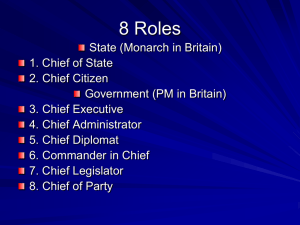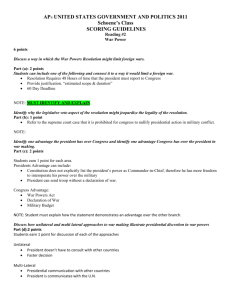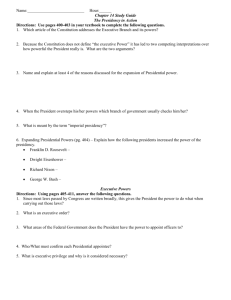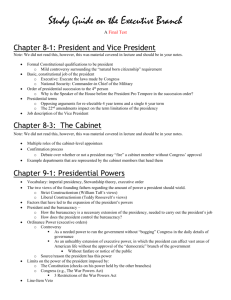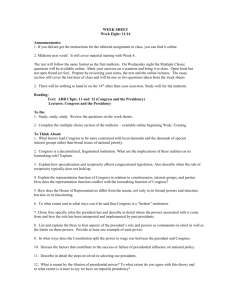Chapter 13
advertisement
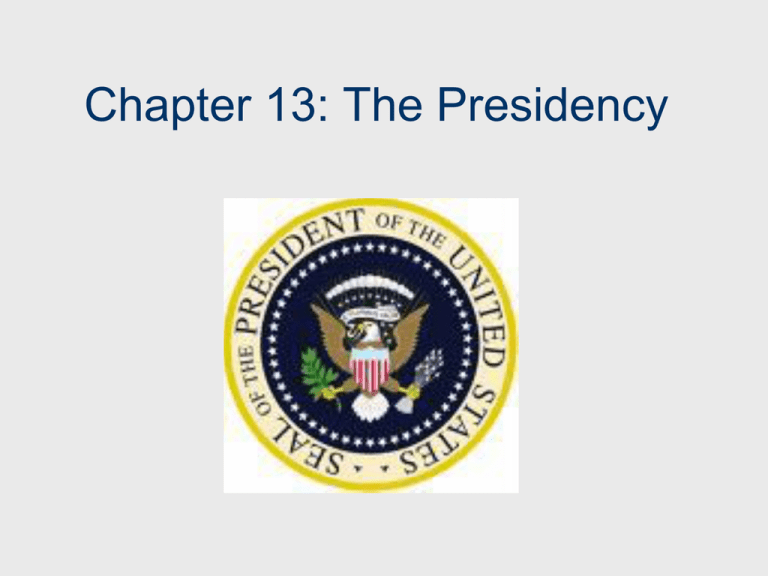
Chapter 13: The Presidency Heads of State and Government Head of State: Ceremonial Duties Head of Government: Policy Making Authority Queen Elizabeth David Cameron The Presidents Article 2: “Executive Powers to be Vested in a president…” Formal Requirements: • Must be 35 years old • Must have resided in U.S. for 14 years • Natural born citizen Informal “Requirements”: • White (except current President) • Male • Protestant (except one) Youngest Youngest elected Only Catholic All manner of professions, but mostly political ones (former state governors, senators, for example) History of the Presidency: Deliberations at the Constitutional Convention Alternatives Plural executive, executive council to have veto power over presidential actions, Alexander Hamilton wanted a President with a life term. Eventually, compromises brought about a single, elected President with a fixed term of office. History of the Presidency: Concerns of the Founders. Fear of an excessively strong President. Fear that the presidency would be the “fetus of monarchy” (Edmund Randolph). Concern over no term limits (no 22nd Amendment until 1950). Fear of an excessively weak President who would become a “tool of the Senate” because of its ratification and confirmation powers. Gouverneur Morris: “Make him too weak: the legislature will usurp his powers. Make him too strong: he will usurp the legislature.” History of the Presidency: Election of the President. Some wanted Congress to elect the President Some wanted direct election. The compromise: the Electoral College. The people had some input, Large states had a good amount of influence, Small states would also have a great deal of clout if the election were thrown into the House (and it was assumed that this would happen often). History of the Presidency: Term of Office Fear of an unlimited number of terms of office were quieted when Washington chose not to run for a third term. This precedent was followed until 1940. History of the Presidency The First Presidents: Washington-Monroe (17891825) Andrew Jackson (1829-1837) Reemergence of Congress (1837-1932) Emergence of the modern Presidency (1932present) The Presidents Elections: The Normal Road to the White House Once elected, the president serves a term of four years. In 1951, the 22nd Amendment limited the number of terms to two or ten years. Most Presidents have been elected to office. The Presidents Secession and Impeachment The Vice-President secedes if the president leaves office due to death or resignation or convicted of impeachment New non-elected VP needs approval from both houses resigned Impeachment is investigated by the House, tried by the Senate with the Chief Justice presiding. Only two presidents have been impeached: A. Johnson & Clinton- neither was convicted. Presidential Line of Succession # 1 2 3 4 5 6 7 8 9 10 11 12 Office Vice President of the United States Speaker of the House President pro tempore of the Senate Secretary of State Secretary of Treasury Secretary of Defense Attorney General Secretary of the Interior Secretary of Agriculture Secretary of Commerce Secretary of Labor Secretary of Health and Human Services 13 14 15 16 17 18 Secretary of Housing and Urban Development Secretary of Transportation Secretary of Energy Secretary of Education Secretary of Veterans’ Affairs Secretary of Homeland Security Current Officer Joe Biden (D) John Boehner (R) Orrin Hatch (R) John Kerry (D) Jack Lew (D) Chuck Hagel (R) Eric Holder (D) Sally Jewell (D) Thomas Vilsack (D) Penny Pritzker (D) Thomas Perez (D) Sylvia Mathews-Burwell (D) Julian Castro (D) Anthony Foxx (D) Ernest Moniz (D) Arne Duncan (D) Robert McDonald (D) Jeh Johnson (D) Incomplete Terms The Presidents 25th Amendment (1967) Applies when the President is disabled or otherwise unable to perform duties When possible- informs Congress and the VP becomes the acting President If the President cannot inform Congress- the VP and majority of the Cabinet can go to Congress and get approval for VP to be acting President President regains powers by informing Congress of intent to return. In the case of dispute- Congress determines who will be President Compensation Set by Congress. Up until 2001, it was $200,000. Now it is 400,000 Other “perks” Opportunity to make serious money after leaving office (Speaking fees, books, corporate boards) Constitutional (Formal) Powers Domestic Chief Legislator Veto bills State of the Union Address Chief Executive Chief Jurist Chief Economist Administrative Nominations Judicial Nominations Inherent Powers Louisiana Purchase Foreign/National Security Commander-in-Chief of the armed forces Chief Diplomat Make treaties with other nations (Chief Diplomat) Chief of State Receive ambassadors (Head of State) Informal powers established over time: Presidential precedent Washington turning to a cabinet for advice Actions of Congress - giving president power 1965 Gulf of Tonkin Resolution v. War Powers Act. Media’s use of the Bully Pulpit. Prez goes directly to the people. Clinton in ‘97 budget freeze. . .Congress lost that battle. Managing a Divided Gov’t- 16 of the 23 Congressional + Prez elections since 1952 have produced divided gov’ts. George Bush’s administration of 2000 was only the 3rd time since 1969 that ONE party controlled both the WHite House and Congress, and the first time since 1953 that the Republicans ruled. . .and that lasted only one year. WHY? Informal Powers Cont. Chief of Party Selects party chairman of national committee Political patronage Executive agreement a presidential agreement with another country that does not require Senate approval Informal Powers Cont. Executive order a presidential order that has the force of law and does not require congressional approval Must be tied to President’s Constitutional powers • Executive agencies, commander-in-chief, enforcement of laws, etc. Can be overturned by next administration and subject to judicial review The Executive Branch The Vice President Few official constitutional dutiesBecome President if needed and President of the Senate Often chosen based on state they are from or filling in a weakness gap Recent presidents have given their VPs important jobs- stepping stone to Presidency? The Cabinet Presidential advisors, not in Constitution (can’t be in Congress) Is made up of the cabinet secretaries (14) of the federal departments, confirmed by the Senate The Executive Branch 5 others who hold Cabinet rank (OMB Director, CIA Director, White House Counselor, UN Ambassador, US Trade Rep.) Cabinet officials are more interested in their own departments than meeting with others to deal with public policy President’s can fire the Cabinet secretaries but have almost no control of the >90% of civil service employees in the departments (Sub-Cabinet positions) Factors affecting selection of Cabinet Secretaries: Party affiliation, interest groups, race, sex, geography Running the Government: The Chief Executive/Chief of State The Executive Office Made up of several policymaking and advisory bodies Three principle groups: NSC (coordinates foreign/military policy), CEA (3-person advisory group on economic policy), OMB (prepares annual budget and reviews federal programs) Running the Government: The Chief Executive/Chief of The White House Office State The White House Staff are the chief aides and staff for the president. They are chosen on the basis of their loyalty to the president- if not loyal then find a new job! Need not be confirmed The national security advisor is an example. First Lady and 3 Theories of Presidential Access First Lady No official government position, but many get involved politically Recent ones focus on a single issue 3 Theories Pyramid: President, VP, Chief of Staff, etc. Circular: all have equal access and power status Most President’s eventually end up here Reagan, Ike, Nixon Carter, FDR Ad hoc: If you are willing and able, come on down! Alienates Cabinet but allows for free flow of ideas Presidential Leadership How get others to follow Act of Persuasion Constitution is vague on what the President can do. . .so great leaders get creative -- Powers enhanced by: national constituency ceremonial head of state and party, at least in first term. This can erode quickly if one’s party deserts you and others compete in the primaries against you! Three target audiences DC political pundits - can one do the job? Can one possess power- (charismatic leadership) One gets 100 days to show your stuff! Make it count because the “honeymoon is over.” Partisan grassroots- Chief of Party- Be a good Republican or Democrat Joe Public- Use the polls to your advantage. TV spots are what you make them. When you are hot, your legislation flows, your fellow party people get reelected. (coat-tail effect) Presidential Leadership of Congress: The Politics of Shared Chief Legislator Powers Veto: Sending a bill back to Congress with the reasons for rejecting it. Can be overridden. Pocket Veto: Letting a bill die by not signing it in 10 days when Congress is adjourned. Line Item Veto: The ability to veto parts of a bill. Some state governors have it, but not the president. The president must sign or veto all of a bill. Proposes Legislation Calls special sessions of Congress Signing Statements A signing statement is a written message issued by the president upon signing a bill into law that states objectives to some of the provisions in the bill. They are not provided for in the Constitution. Ronald Reagan increased their use, and presidents after have continued this trend. Before Reagan, only 75 had been issued in our history Signing Statements Cont. Power from the People: The Public Presidency Going Public Public support is perhaps the greatest source of influence a president has. Presidential appearances are staged to get the public’s attention. As head of state, presidents often perform many ceremonial functions- which usually result in favorable press coverage. Approval Ratings Power from the People: The Public Presidency Presidential Approval Receives much effort by the White House Product of many factors: war, the economy, the “honeymoon” period Changes can highlight good / bad decisions Presidential Leadership of Congress: The Politics of Shared Powers Mandates • Perception that the voters strongly support the president’s leadership and policies • Mandates are infrequent, but presidents may claim a mandate anyway Approval Ratings Presidential Leadership of Congress: The Politics of Shared Powers Legislative Skills Variety of forms: bargaining, making personal appeals, consulting with Congress, setting priorities in the State of the Union address. Most important is bargaining with Congress. Presidents should use their “honeymoon” period Nation’s key agenda builder The President and National Security Policy Chief Diplomat Negotiates treaties with other countries Treaties must be ratified by the Senate Signs executive agreements to take care of routine matters with other countries May negotiate for peace between other countries Leads U.S. allies in defense & economic issues The President and National Security Policy Commander in Chief Writers of the Constitution wanted civilian control of the military Presidents often make important military decisions Presidents command a standing military and nuclear arsenal Presidents can deploy troops without congressional consent. The President and National Security Policy War Powers Resolution Constitution gives Congress the power to declare war, but presidents can commit troops and equipment in conflicts War Powers Resolution requires the president to consult with Congress before sending troops, when possible It requires that Congress approve of any troop commitment beyond 60 days. Most presidents have ignored it. Supreme Court avoided it using the political questions doctrine. The President and National Security Policy Crisis Manager The role the president plays can help or hurt the presidential image. With current technology, the president can act much faster than Congress to resolve a crisis. Working with Congress President has lead role in foreign affairs. Presidents still have to work with Congress for support and funding of foreign policies. The President and the Press Presidents and media are often adversaries. Many people in the White House deal with the media, but the press secretary is the main contact person Media is often more interested in the person, not the policies News coverage has become more negative



